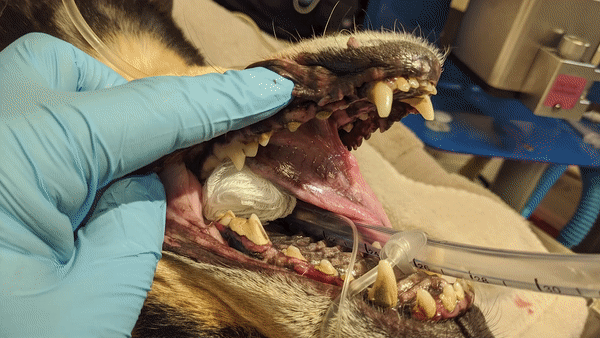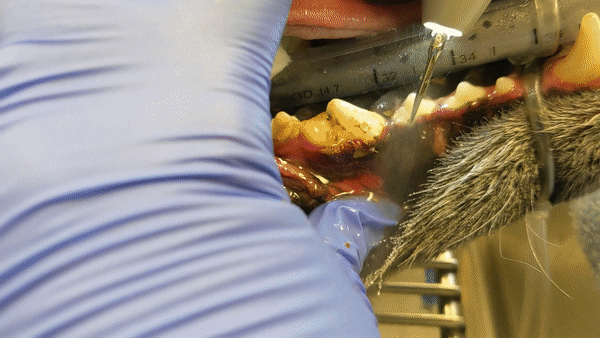top of page


DENTALS



Dental health is just as important for our pets as it is for us!
It is estimated that nearly 80% of pets have some degree of periodontal disease by the age of three, which is why dental exams and routine dental cleanings are essential. When left untreated, periodontal disease can lead to cardiac disease, kidney infection, liver infection, and more. Not to mention, it's uncomfortable! Imagine having a toothache for YEARS?!
What does a dental exam involve?
Pets can experience many of the same dental issues that humans do, including gingivitis, periodontal disease, tooth loss, oronasal fistulas, infections, and more. Regular dental exams and dental cleanings can limit and/or prevent your pet from suffering unnecessary pain and complications, and can help you avoid a costly trip to the dental specialist.
Dental exams are typically performed by our veterinarians during routine wellness exams and dental consults. We determine what "grade" or condition the teeth are in, and check for any obvious damage, fractures or root exposure. Based on this information, we can create a dental estimate for your pet, so that you are prepared for the cost of a dental procedure with our office. You will ALWAYS have the option of taking your pet to a dental specialist, and we are happy to refer you (https://www.azvetdentists.com/).
What does a dental cleaning involve?
Proper dental cleanings require full anesthesia. You may find groomers or other facilities that advertise "anesthesia-free cleanings," but these procedures are neither safe nor truly effective. It's nearly impossible to thoroughly scale all of your pet's teeth if they are awake! Let's not even talk about how unkind it would be to EXTRACT teeth on a pet that was not under anesthesia!!!
Because true dental cleanings require full anesthesia, we require pre-anesthetic blood work prior to administering anesthesia. We do this to check your pet's liver and kidney function, and to make sure they are a good candidate for anesthesia. After all, administering anesthesia to a pet in liver or kidney failure could have dire consequences. This bloodwork can be done up to 30 days in advance of the dental cleaning, or on the morning of. Either way, the results will be reviewed by a veterinarian before we move ahead with the procedure.
After the vet has reviewed the bloodwork results, the next step is to place an IV catheter, so that your pet can receive IV fluids throughout the procedure. Once the catheter is set, we move forward with anesthesia. Your pet is intubated and placed on an inhalant anesthetic for the duration of the dental.
The dental begins with a technician getting full-mouth radiographs, so the vet can assess the condition of the teeth below the gums - this often helps us identify hidden issues, like rotten roots and more. After obtaining the radiographs, and while the vet reviews them, the tech then begins the cleaning process by gently scaling the surface of the teeth with an ultrasonic scaler. This is how we safely remove tartar and plaque from the surface of the tooth and beneath the gumline. Once scaling is complete, the vet steps in to assess the condition of the now-plaque-free teeth - checking for gum recession, exposed roots, bifurcations, fractures, and more. The vet then begins the extraction process. Once extractions are complete, we get another x-ray of the mouth, to make sure we've gotten all of the bits and pieces necessary for a full recovery. After reviewing the post-extraction x-rays, the vet then gives the technician the go ahead to polish any remaining teeth. Once the polishing is complete, the anesthesia ends and your pets is gently woken up in a cozy kennel, where they can recover peacefully.
We're often asked if the vet will call you before going ahead with necessary extractions, and the answer is no. We would lose valuable time if we stopped every procedure to place a phone call that may or may not be answered, and that could increase the risk of anesthetic-related complications. In addition, we need you to trust us. We only extract teeth that absolutely need to be extracted. Extractions are difficult and take a long time to complete , and we've never met a veterinarian that actually enjoyed pulling teeth. So, please trust that we only pull teeth that absolutely need to be pulled.
If you want to save as many teeth as possible, we hope you'll seriously consider taking your pet directly to a dental specialist. That's literally why dental specialists exist! https://www.azvetdentists.com/
Need dental x-rays?
No worries! We are equipped with a state-of-the-art panoramic dental radiograph unit - which allows us to take full-mouth x-rays in under a minute!
The MyVet Pan i2D™ is the world's first veterinary specialized mobile panoramic dental x-ray system!
-
Small animal specific panoramic dental image processing technology:
The MyVet Pan i2D uses tomography to take a panoramic image of small animal's full mouth within a minute.
-
Fast, easy and more diagnostic for one study:
Actual scan time is approximately 20 seconds for full mouth. Panoramic images provide more coverage for bone defects and jaw lesions.
-
Infection prevention and control:
Our panoramic system does not require any intraoral sensor, this is typically shared among patients in the clinic setting. This helps prevent our patients from developing infections from cross contamination of bacteria, and has no potential for causing them discomfort from positioning an intraoral sensor.



Chica, our clinic cat, taking our new Dental PanoRad Equipment for it's first spin!

And our very first radiograph! These radiographs can even be helpful in visualizing the sinus cavity!
To schedule a dental consult, please call our office or visit our online booking tool.
bottom of page
